Vulnerability encompasses far more than simply admitting to mistakes or uncertainties. It embodies a willingness to engage authentically with oneself and others, even in the face of discomfort or potential judgment. In the words of Brené Brown (2012), vulnerability is the birthplace of innovation, creativity, and change. It’s the willingness to show up and be seen, even when there are no guarantees of acceptance or validation.
Read the short section below and reflect on what resonated for you.
We can look at the following interrelated beliefs, characteristics, and behaviors to help us understand more about the specific aspects of vulnerability:

A vulnerable mindset encourages individuals to be open and authentic about their thoughts, feelings, and experiences. It involves embracing one’s true self, including both strengths and areas of growth.

Individuals with a vulnerability mindset are willing to share their thoughts and emotions with others, even when it feels uncomfortable or exposes them to the possibility of judgment. This aspect recognizes the value of genuine connections and relationships.

Embracing vulnerability means accepting imperfections and acknowledging that everyone has areas of vulnerability. It involves letting go of the pursuit of perfection and recognizing that vulnerability is a natural part of the human experience.

A vulnerability mindset acknowledges that facing challenges and setbacks is a part of life. Instead of avoiding vulnerability, individuals practicing this aspect see it as an opportunity for personal growth, learning, and resilience.

Individuals with a vulnerability mindset are often more empathetic and compassionate towards others. They understand that everyone has vulnerabilities, and this understanding fosters a sense of connection and empathy.

Embracing vulnerability involves acknowledging and learning from mistakes. Instead of viewing mistakes as failures, individuals practicing this aspect see them as opportunities to learn and improve.

Read the short section below and reflect on what resonates for you.
Embracing vulnerability means acknowledging that we do not have all the answers and that learning is a continuous journey. It requires a willingness to step outside our comfort zones, challenge assumptions, and engage in courageous conversations that foster deeper understanding and empathy.
When partnering with youth for change, vulnerability takes on added significance. It requires educators to relinquish the traditional role of authority and embrace a more collaborative approach that honors the voices and experiences of young people. By modeling vulnerability, educators not only create spaces where youth feel valued and empowered but also demonstrate the importance of lifelong learning and growth.
For example, in Classroom co-design, Ms. Perro demonstrates vulnerability as she works with her students to better understand what is working and not working and then learns alongside them as they try out different ways to improve a sense of belonging in the class. In the Student-powered math classroom case study, Ms. Ashby is vulnerable with her students as she works alongside them to redefine care and implement changes to be more open, authentic, and empathetic.
As we navigate the terrain of vulnerability in education, it’s crucial to also recognize that the ability to be vulnerable is not evenly distributed. For marginalized individuals, the risks associated with vulnerability can be amplified by systemic inequities and societal prejudices. It is difficult and sometimes dangerous to be open and authentic when there is a valid fear of being misunderstood, marginalized, or even attacked.
How we define vulnerability is highly dependent on context and, like many other mindsets, there is no right or wrong way to be vulnerable. Instead, vulnerability falls along a spectrum that depends on the conditions around us. Cultivating vulnerability in Student-Powered Improvement requires reimagining the systemic barriers that block genuine expression and marginalize certain voices. It entails co-creating inclusive learning environments where all individuals feel seen, heard, and valued for their unique perspectives and contributions.
Below are activities that educators have used to explore vulnerability in classrooms, schools, and teams.
Explore the mindset of vulnerability and its role in fostering openness, authenticity, connection, and personal growth.
Explore aspects of vulnerability together to cultivate the learning environments, deepen understanding, and gain insights.